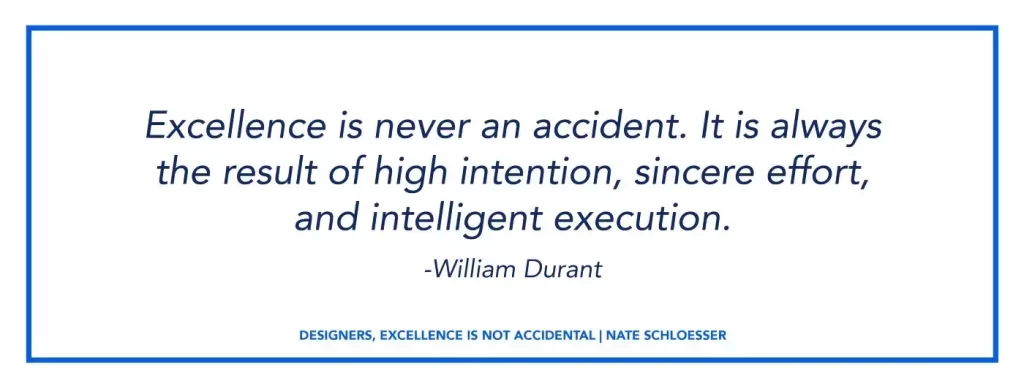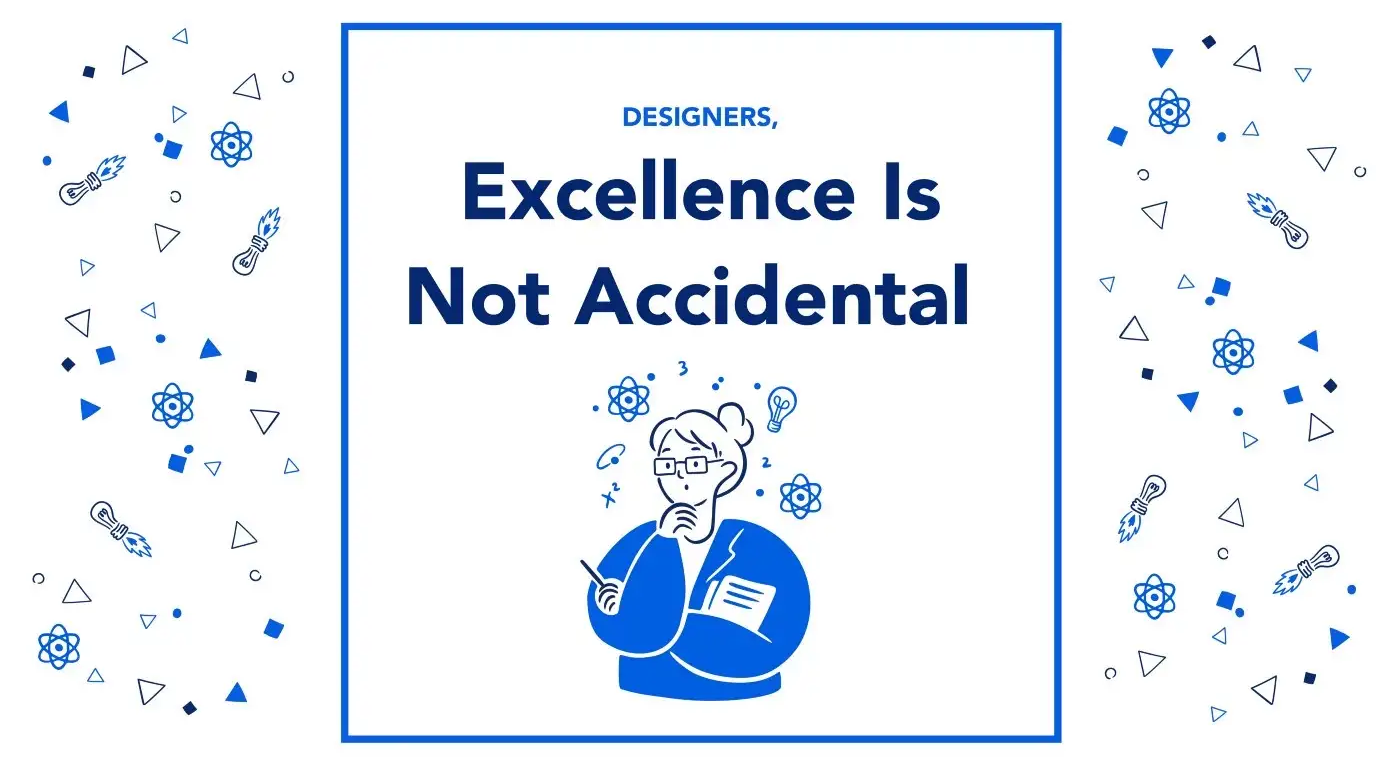Over the past few months, I’ve been fervently pondering what it takes to achieve excellence in my life and more specifically, design work. Recently, I began pouring more reading time into the subject and came across some powerful references. The quotes and thoughts are often attributed to Socrates, but, in fact, they are of William Durant, an American writer, and philosopher from the turn of the 20th century. William Durant would often read and meditate on Socrates’ words and then restate the meaning of Socrates’ message in his own words. This has helped to amplify the words of Socrates so much that William Durant’s words are often mistakenly taken as direct quotes of Socrates. Whether you attribute these words to Socrates or William Durant is not actually the point of the article—though I did want to make sure the right person received credit. The point of this article is that excellence is not something you stumble into. Excellence is deliberate.
Excellence is a Habit
If you or I as a designer, have the desire to be excellent, it starts with mastering our craft through learning and making a habit of putting what we learn into practice. If we learn but do not practice what we learn, we will not achieve excellence. If we skip learning and practice from our instincts, we will not achieve excellence. We are what we do. If we want to be excellent then we must actually practice excellence.
Excellence is an art won by training and habituation. We do not act rightly because we have virtue or excellence, but we rather have those because we have acted rightly. We are what we repeatedly do. Excellence, then, is not an act but a habit. — William Durant.
This practicing and acting isn’t a one-time thing nor is it seasonal. It has to be a part of who you are as a designer. You will never know everything about the craft; therefore, you always have to be learning and growing. After 16 years in the field of design, I am more aware of what I don’t know than what I do know. We must continue to challenge ourselves and each other—refusing to become stationary or settle for mediocrity. This has to become part of our very being.
Moving towards mastery through learning and training is where excellence begins. Without that, you can’t effectively create the right habits. But what does creating those habits look like?
Excellence is Deliberate
Excellence is never an accident. It is always the result of high intention, sincere effort, and intelligent execution — William Durant.
High Intention
Excellence requires a deliberate plan. For me, this looks like setting annual goals which are broken down into quarterly milestones, then monthly and weekly tasks. Excellence is not accidental. You will not stumble into it. Set a goal and make plans toward this goal.
A number of years ago, I had a goal to develop the discipline of product strategy at Covenant Eyes. I knew I wasn’t the person for the job—I didn’t have the bandwidth nor the desire to lead strategy. But I did see a need, I knew of an individual who had the skills and desire for the work, and I knew I could develop and support the area of strategy without being the point person.
I came up with a 2-year plan. In the first year, I would hire a Strategic Designer who would work alongside me. I needed to develop discipline and support within the organization. I needed to establish the Strategic Designer as the authority for Product Strategy. The two of us would work on projects together in the area of Strategy. I used my credibility to establish this area of work. At the same time, this individual began attending trainings, conferences, reading books, etc. He had his own goals to help achieve excellence. As he learned, he would take what he learned and put it into practice on our projects. We had regular milestones around learning and projects. Every quarter, there was a project around Strategy, and this person would have the opportunity to practice their craft. My goal was to slowly move out of the role completely. For the first project, we worked side-by-side. The second I took point still but did less of the work. By the third, he was taking point and I was backing him up. By the fourth project and a year into this, I was a stakeholder. After that first year, I stopped working in Product Strategy all-together.
The second year’s goal was more focused on continuing support, better integration within the organization, and deepening the authority of Product Strategy. The point though is that there was a plan. Nothing happened accidentally.
To achieve excellence you need a deliberate and achievable plan.
Sincere Effort
A plan is well and good, but without a vigorous and determined attempt at the plan, nothing will happen either.
As I executed my plan, unforeseen things happened along the way. Many of these occurrences threatened my plan and could be distracting. However, each time things came up that were important and unavoidable. Things don’t always go according to plan.
In the midst of these efforts, several things happened. A fellow design leader left the organization and I became responsible for his team. It became my duty, responsibility, and joy to manage this group of designers. But now, I had another plan to attend to as well. Next, the Product Strategy was proving to be challenging. There was confusion around the direction and many cooks were in the kitchen. Product Strategy required attention. My plan was requiring adjustments. If at any point if I had set aside my plan, excellence would never be achieved. I had to stay determined and find ways to make time for my original plan, while I adjusted it for curveballs. Additionally, I had a second plan related to absorbing a design team. I had to find a way to balance both.
To achieve excellence you need consistent, deliberate, unrelenting effort and focus.
Intelligent Execution
Excellence requires putting a plan into action with an understanding of the context in which that plan has to be carried out. This means working with the right people, operating within the given frameworks or processes of an organization, and understanding how things get done at your specific organization.
At Covenant Eyes, our best work receives support and gains traction when an executive cares about the work. Knowing this is important. If you care about something that you think is good, getting an executive to care about it is a good place to start. If Product Strategy is going to gain traction, I need an executive to see its value of it and advocate for the work. I need someone to request this type of work.
When it comes to the direction and vision for Product work, Covenant Eyes has a Product Leadership team—which I am a member of. There is a VP of Product and a Product Manager that play a key role in how we decide the direction of the Product. If my plan was going to work, I needed to find a way to get Product Strategy a seat at that table.
Another challenge I had was that Strategy, by nature, is disruptive, distracting, and can cause angst within an organization. I needed a space for there to be rich discussion and debate around ideas and initiatives that were coming from Product Strategy. I ended up creating a Weekly Round Table where myself or my Strategist would bring a contentious topic and facilitate open discussion. Participants were encouraged to speak freely without repercussion. Eventually, I moved out of the facilitation role for Round Tables and handed all of that over to the Strategist.
Another challenge is that I have designers operating at all levels of the organization. How does Product Strategy impact them? I had to find ways to distinguish Product Strategy from UX Strategy and from Service Design.
Excellence in design requires intelligent execution by understanding the context in which a plan must be carried out.

Even with high intention, sincere effort, and intelligent execution, I’m not sure I can say I reached excellence. I definitely made some mistakes along the way that I’m still learning from. If excellence was achieved, then the success should be attributed to John for his part in making his own effort toward excellence. Even still, the whole thing is much better than if either one of us would have merely stumbled through—relying on instinct.
As a designer, you will never achieve excellence by accident. It will always be the result of an intentional plan, deliberate effort, and execution with intelligence. To pull this off, you need to continue to grow in mastery of your craft.








